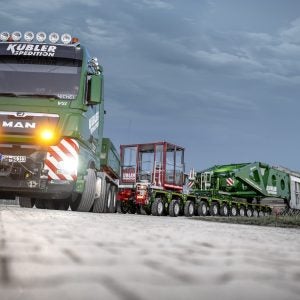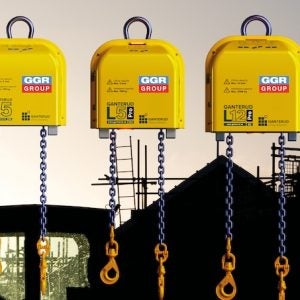The successful use of simulation training and testing to meet German requirements for crane operator certification was demonstrated at the Bauma trade show by Canada-based simulation specialist CM Labs Simulations.
At the show operator-in-training Patrick Schultka, who had no experience with cranes, spent eight hours over the course of four days at the show using CM Labs’ Tower Crane Simulation Training Pack on its Vortex five-screen Advantage Simulator.
With self-guided practice and one-on-one coaching from a trainer he completed a written exam, plus a 30-minute qualification test, using CM Labs’ Crane Training Pack based on the real-world CCO exam.
According to CM Labs, in September 2021, German Statutory Accident Insurance (DGUV – Deutsche Gesetzliche Unfallversicherung) issued report FBHL-019 allowing the use of simulation systems for the qualification of heavy equipment operators. DGUV, the organisation that oversees the use of simulation for heavy equipment training in Germany, helps companies and educational institutions with a range of prevention measures and services.
Matthias Mueller, management safety engineer and owner of AST (Arbeits Sicherheit & Technik, a recognised educational institution), supervised the live certification and documented the process. AST has been using CM Labs simulators for the past two years to qualify operators in accordance with DGUV guidelines.
“Using simulation to certify crane operators offers the next level of training and development in the skilled trades,” said Lisa Barbieri, CM Labs’ VP of marketing and product management. “The requirements set by DGUV are essential to creating a unified objective standard of measure to use simulation for certification in Germany. CM Labs is positioned to provide the right solution as the industry evolves to take advantage of the benefits of simulation training in new ways.”
The DGUV report stipulates that simulated curriculum must include realistic use of the equipment, real-world scenarios to reinforce correct safe working interactions and habits, and problem-solving scenarios to establish good judgment for safe operation and avoiding near collisions and injuries.
Simulation for certification must meet five technical criteria in order to comply.
- Realistic immersive display (such as curved or 5-sided case);
- Acoustic feedback to reinforce audio queues common on the job site (engine, alarms, etc.);
- Realistic motion system – such as 5 degrees of freedom and motion platform;
- Faithful replica of a typical worksite for operator context;
- Realistic high-quality simulation model – real-time simulation, vehicle behaviour, steering, vibrations, the behaviour of objects and materials, graphics, and environmental scenarios (night/day/wind gusts, etc.).
CM Labs claims it accurately replicates real-world machine and materials behaviour resulting in effective, efficient operator training. The company even claims its’ patented physics-based Smart Training Technology (STT) system actually exceeds the technical criteria for German certification.
The STT comprises proprietary and patented algorithms designed to deliver a simulation that models machines as they would react with the environment and materials in the real world, explains CM Labs.
Its precision is backed by more than 20,000 automated daily tests and ongoing research and development. The company says that by using the system trainees gain a better feel for engine transmission, crane boom, and jib bending/torquing, as well as wire rope and crane block spin and environmental factors like wind, precipitation, day and night settings.
A video from CM Labs about the use of simulators in operator training in Germany can be seen here: www.youtube.com/watch?v=TR9KYT7v62M






